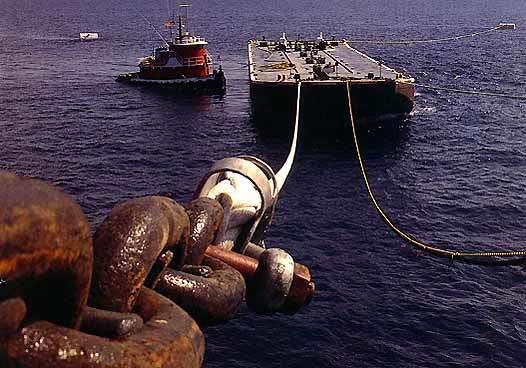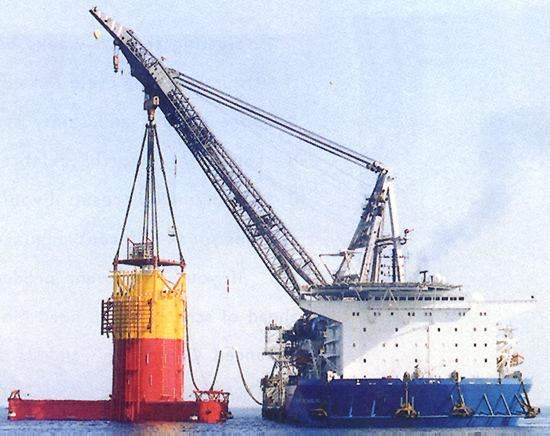The Morpeth field is located in 1700ft of water, in the Gulf of Mexico Ewing Bank (EW) blocks 921, 964 and 965, off the shore of Louisiana, US.
It was developed by British Borneo, although the company has since been acquired by Agip.
Reserves
Following the successful testing of Morpeth well EW 965 no 1, proven and probable reserves were upgraded to 66 million barrels of oil and 67 billion cubic feet of gas (totalling 77 million barrels of oil equivalent (boe), and representing an increase of 50% over the previous estimate).
Upside reserves potential is estimated at around 92 million barrels of oil equivalent. Furthermore, a production test of the main ‘P’ sand reservoir led to a planned production rate of 35,000b/d oil, rather than the 25,000b/d oil originally envisaged.
The crude oil recovered on test from the main reservoir interval was 32° API with a 1.6% sulphur content.
Field development layout
Processed crude oil and natural gas is exported from the Morpeth platform via a 12in oil-export line and an 8in gas-export line to the Grand Isle 115 platform.
The Grand Isle 115 platform lies in 366ft of water near the continental shelf margin, 19 miles from Morpeth. The pipeline system was designed to handle throughput volumes of twice the Morpeth peak production rates.
From Grand Isle 115, the oil continues through the main Amberjack pipeline system to the Clovelly onshore terminal in Louisiana. The gas and gas liquids will go through Texaco’s Discovery pipeline system.
Drilling
The deepwater drilling rig Ocean Endeavor was used to drill three production wells and a water-injection well.
Development strategy
To develop Morpeth, British Borneo selected the small tension leg platform SeaStar. Designed by the Houston-based Atlantia Corporation, the SeaStar mini-TLP has a single surface piercing column.
Being so small, it is relatively transparent to environmental forces.
Hull
The hull provides sufficient buoyancy to support the deck, facilities and flexible risers. The hull consists of a single central column and three radial pontoons.
Three external buoyancy tanks are structurally connected to the central column by means of horizontal and diagonal braces.
Deck
The SeaStar deck provides a stable working platform, safely above the hurricane wave, to support the equipment necessary to process and control production. The spider-deck arrangement has the diagonal deck braces built into the hull section.
The deck yields simple fabrication, onshore hook-up, transportation and installation operations.
The Morpeth deck is 110ft x 110ft and the facilities are spread over two levels. The process equipment will have a design throughput of 38,500b/d and 42 million cubic feet a day of gas.
Tendons
The hull is moored by steel tubular tendons. Tendons can be installed either as single piece or segmented. The single piece tendons can be applicable when suitable fabrication facilities are located near to the installation site, so that the tow distance is relatively short and can be transversed during a predictable weather window.
The single-piece tendon is usually designed as neutrally buoyant, so that it rides slightly below the surface of the water during tow-out. The weight of the connectors at the ends of the tendons is supported by buoyancy tanks. The upper buoyancy tank is larger than the lower tank and serves to hold the tendon upright, before the hull is installed.
Segmented tendons are applicable when single-piece tendons are impractical, for reasons of water depth or transportation. For this approach, tendon segments are shipped to location on a barge and welded together. Alternatively, the tendon segments could be run from a drilling unit similar to a drilling riser.
In either case, a temporary or permanent buoy on the top of the tendon is included, to hold the tendon upright until the hull is installed.
Piles
The piles can either be driven using underwater hammers, or drilled and grouted. For the Morpeth, the decision was made to use a conventional driven-pile solution, because the holding power is more reliable.
Template
The template can be of a multiple or a single piece. The single-piece template concept was selected for the design case because it had the advantage of a simple and positive control over the pile location.
Mooring
Since the tension-leg mooring suppresses heave motions and reduces excursions, the performance requirements of the risers are reduced, in comparison with a catenary-moored platform.
In the case of the Morpeth, the platform supports four satellite subsea oil and gas wells, each approximately 3,000ft from the platform, which flow through individual flexible flowlines, to the platform.
Export
The export lines for gas and oil consist of a steel catenary riser. The proposed method of connecting the flowline risers to the platform is through a series of short I-tubes on the platform base.
Hard piping supported on the outside of the hull directs flow from the flowline riser porch to the deck. Procedures have been developed for the installation of two flexible flowlines and one control umbilical from each well.














